Third Cohort of Mellon-Hawai‘i Fellows Named
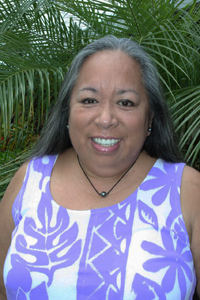
Photo: “I am excited and honored to receive this Fellowship from The Andrew W. Mellon Foundation, Kamehameha Schools, the Kahiau Foundation, and The Kohala Center. Their support of Native Hawaiian Scholars to achieve our dreams by obtaining our doctorate degrees is a remarkable testimony to the organization’s commitment to excellence in education and the well-being of our island communities,” says Noe Noe Wong-Wilson, Mellon-Hawai‘i Doctoral Fellow.
It is wonderful to experience Hawai‘i producing such great writers and thinkers for Hawai‘i—and the world! —Matt Hamabata, Executive Director, The Kohala Center
Five Hawaiian scholars have been selected as 2010–2011 Mellon-Hawai‘i Doctoral and Postdoctoral Fellows in recognition of their commitment to the advancement of scholarship on Hawaiian cultural and natural environments, Hawaiian language, history, politics, and society.
Receiving the doctoral fellowships are:
- Keao NeSmith, doctoral candidate in Applied Linguistics at the University of Waikato in Hamilton, New Zealand;
- Hiapokeikikāne Kichie Perreira, doctoral candidate in the Hawaiian and Indigenous Language and Culture Revitalization Program at the University of Hawai‘i at Hilo; and
- Noe Noe Wong-Wilson, doctoral candidate in the School of Maori and Pacific Development, University of Waikato, New Zealand.
Postdoctoral Fellows are:
- Leilani Basham, Ph.D., Political Science (2007), University of Hawai‘i at Mānoa; and
- Noelani Goodyear-Ka‘ōpua, Ph.D., History of Consciousness (2005), University of California, Santa Cruz.
Fellowship applicants were evaluated on their leadership potential as well as their demonstrated commitment to the advancement of Hawaiian scholarship. They were selected by a distinguished panel of senior scholars and kūpuna (elders) comprised of Robert Lindsey, Jr., The Kohala Center board of directors and Office of Hawaiian Affairs trustee; Dr. Shawn Kana‘iaupuni, Kamehameha Schools; Dr. Dennis Gonsalves, Pacific Basin Agricultural Research Center; Dr. Pualani Kanahele, Edith Kanaka‘ole Foundation; and Dr. James Kauahikaua, U.S. Geological Survey Hawaiian Volcano Observatory.
The Mellon-Hawai‘i Fellowship program provides scholars the opportunity to complete their dissertations or to publish original research. Postdoctoral fellowships amount to $50,000 each, and doctoral fellowships, $40,000. Read more about each of this year's fellows in "Our Ways of Knowing" on the Back Page.

Paddling One Canoe
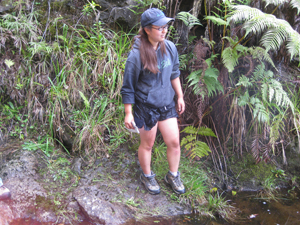
Photo: Grace Ha "crossing" Waiakamali Stream in Kohala.
The Cornell Earth and Environmental Systems (EES) Field Program, currently in its 6th year, counts two Fulbright Scholars among its 50 alumni. Grace Ha (Cornell University, Biological Sciences, 2010), a member of the 2009 EES cohort, was recently awarded a Fulbright Scholarship to conduct a research project on indigenous understanding and utilization of the ocean on Jeju Island, South Korea. The Fulbright Program is an educational exchange designed to increase 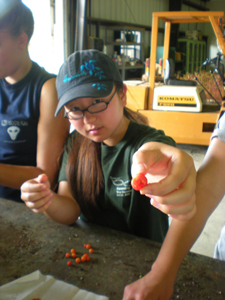 mutual understanding between the people of the U.S. and people of other countries. The program provides participants—chosen for their academic merit and leadership potential—with the opportunity to study, teach, and conduct research, to exchange ideas and contribute to finding solutions to shared international concerns.
mutual understanding between the people of the U.S. and people of other countries. The program provides participants—chosen for their academic merit and leadership potential—with the opportunity to study, teach, and conduct research, to exchange ideas and contribute to finding solutions to shared international concerns.
Photo: Grace planting ‘ākia seeds at the State tree nursery in Waimea.
Is there something special about spending a semester living and learning on Hawai‘i Island that encourages students to pursue international education? “I think so,” says Program Director Alexandra Moore. “On campus, on the mainland, students are challenged to show what they can do. And while we issue that same challenge here, many of our island mentors also challenge our students to find out who they are, and to figure out what is their special kuleana—what is the area in which each of them can make a difference in the world. There is no doubt that Hawai‘i, the ‘āina (land), and our kumu (teachers) here inspire all of us, and encourage us to view the larger world as an island—as a canoe—in which we all need to work together,” explains Moore.
Read more about Grace Ha’s journey in "The Diving Women of Jeju Island" on the Back Page.

Reflections on EES 2010
By Alexandra Moore, Cornell EES Program Director
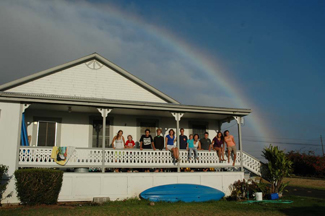
Photo: A rainbow arches over ‘aka House, home to Kumu pa‘a i ka ‘āina, the Cornell University environmental science field program.
As we pack to return to the mainland we pause to gaze at the beautiful ānuenue (rainbow), and to reflect on the past five months. Amazing! We are indeed fortunate to be able to spend time here, learning from the island itself and from so many generous people, especially those who mālama (care for) this extraordinary place.
2010 marks the second year we have undertaken the challenge of living as a carbon-neutral program. This year we were able to fine-tune our carbon-neutral strategy, and to measure the results of our first year's efforts. Learn more about how we did in "Re-growing a Forest or Two" on the Back Page.

Hawai‘i Island Seed Exchange
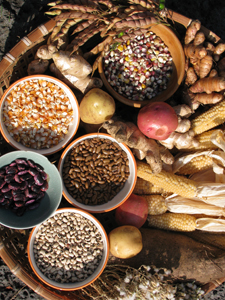
Photo: Some of the seeds grown on Nancy Redfeather’s Kawanui Farm. Lettuce, potatoes, corn, beans, black eyed peas, uhi (yam), ‘ōlena (ginger), popcorn, and sweetcorn. Photo by Julia Rosekrans.
Seed savers from around the island are invited to the 8th Annual Hawai‘i Island Seed Exchange from 9:00 am to noon on Saturday, June 19, at the Amy B.H. Greenwell Ethnobotanical Garden in Captain Cook. “This year’s exchange will be very different from the previous years,” says Coordinator Nancy Redfeather. “Since we just hosted the Seed Symposium last month which created a statewide seed working group comprised of representatives from UH Mānoa, UH Hilo, and the various islands, this year’s Seed Exchange will be more of a planning meeting than a festival,” she says.
The Exchange will open with a short meeting to discuss the creation of seed working groups around the island, for the purpose of sharing knowledge, building a network of seed savers, and conducting variety trials and field days at various farms. Redfeather will then demonstrate cleaning and saving lettuce seed, and participants will have the opportunity to exchange seeds with one another. “If you have seed you have saved from food crops that do well on your farm or in your garden, and you would like to offer some to the gardening community in exchange for taking home seed from others, please join us and there is no charge,” says Redfeather. Participants are also invited to bring cuttings and roots, but no potted plants, so as to avoid spreading the Little Fire Ant. Participants who do not bring material to exchange will be charged a $10 entry fee. Proceeds will help fund the next Seed Exchange in 2011. Participants who would like to stay for lunch are invited to bring their own lunch or to purchase lunch and join the group from noon to 1:00 p.m. For more information, contact Redfeather at nredfeather@kohalacenter.org.

Sharing Big Ideas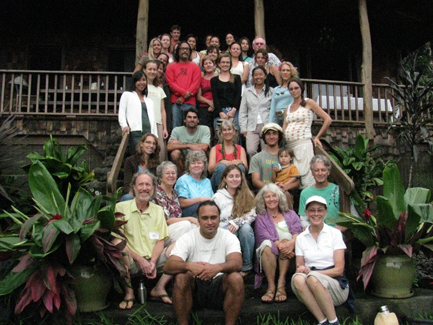
Photo: 2009 Hawai‘i Island School Garden Network Summer Conference participants on the porch of Nancy Redfeather’s Kawanui Farm.
Garden teachers from around the island and across the state will gather at The Mala‘ai Culinary Garden of the Waimea Middle School on July 16–18 for the annual Summer School Garden Conference. Staff from the Center for Ecoliteracy in Berkeley, California, will share their practical, hands-on school garden curriculum, "Big Ideas," with our garden teachers. This garden curriculum connects with classroom curriculum and State benchmarks to bring learning alive for students. Presenters from the Center for Ecoliteracy include Executive Director Zenobia Barlow, Director of Education Carolie Sly, and Creative Director Karen Brown. Learn more about this summer’s "Smart by Nature - Growing School Garden Curriculum” at www.ecoliteracy.org.
The Hawai‘i Island School Garden Network (HISGN) recently received a letter of commendation from Governor Linda Lingle for its role in the Green Thumb Challenge, a nationwide effort to establish 10,000 school/community gardens by year’s end. Read the full text of the Governor's letter.

Wonderful Questions
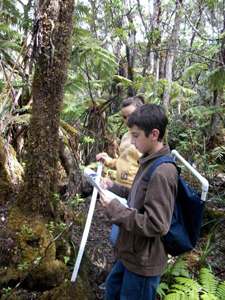
Photo: Waikoloa Middle School students worked in the Kohala rainforest. Their research questions included: How does elevation affect the amount of moss, the water quality of water from moss, and water quality in the stream? among others.
On one of the first field trips with the Waikoloa Middle School kids, I did a "squeeze the water out of the moss" demonstration. Not only did this generate wonderful questions about how much water the moss was holding, but also got the kids thinking about the water itself. Can you drink it? Does it have living things in it?
—Melora Purell, Coordinator, Kohala Watershed Partnership and HI-MOES Outdoor Educator
Over the past year, roughly 400 students and 12 teachers were engaged in designing and implementing their own science projects in the ahupua‘a (watersheds) of Kahalu‘u, Kohala, and Kūki‘o through The Kohala Center’s NOAA-funded HI-MOES (Hawai‘i Island Meaningful Outdoor Experiences for Students) Program. Students looked at how environmental variables affect everything from the variety of critters inhabiting tide pools along the Kona Coast to the moisture content of mosses in the wet forests of Kohala. On May 4, students from nine West Hawai‘i schools gathered at the Gateway Center at the Natural Energy Laboratory of Hawai‘i Authority to share the results of their scientific research with their peers. Their teachers report that having the opportunity to do “real” science motivated their students to look deeper and analyze their findings. “Students absolutely loved it—looking forward to next year!” wrote one teacher on her year-end evaluation. “Many students said it was their favorite science experience for the year,” said another.
Read "Real Research" on the Back Page.

Farming for a Living
By Una Greenaway
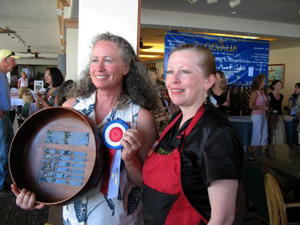
Photo: Una Greenaway (left), owner of Kona Old Style Coffee, took first place at the 2007 Gevalia Kona Coffee Cupping Competition.
Editor’s Note: Una Greenaway is a nationally recognized sustainable farmer. Una is President of the Kona Country Farm Bureau, a member of the Hawai‘i County Agricultural Development Plan Health Impact Analysis team, Western SARE (Sustainable Agriculture Research and Education) Advisory Board member, and owner of Kuaiwi Farm in South Kona for the past 33 years. She was just selected as a 2010 Sustainable Farming Mom of the Year by the Women, Food, and Agriculture Network.
I moved to Kona with my husband and one-year-old daughter in 1977. We were part of the “back-to-the-land” movement and wanted to farm and live off of the land. We were lucky to find a beautiful piece of land in Captain Cook with lots of soil. Our farm also had old coffee trees that were planted in about 1900. I learned a lot about coffee farming from my Japanese neighbor, whose grandfather had planted our old trees. From the start we were committed to using only organic methods to help to heal the land from years of herbicide use. Read "Work Hard, Compost, and Other Farm Survival Skills" on the Back Page.

500 Light Bulbs
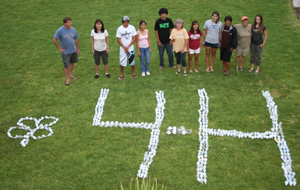
Photo: Here’s what the Hilo 4-H group did with the 500 incandescent light bulbs they collected.
The Kohala Center's compact fluorescent light (CFL) bulb exchange was a runaway success at two locations in Hilo. Folks lined up to trade in their old incandescent bulbs for new CFL bulbs at the 4-H exchange at Kino‘ole Farmers' Market and at Waiakea High School. Groups earn $1 per bulb exchanged through this island-wide initiative sponsored by TKC and Blue Planet Foundation. Learn more about the CFL Light Bulb Exchange at http://www.kohalacenter.org/bulbexchange2010.html.


Subscribe to Kalei Nu‘uhiwa's Hawaiian Moon Newsletter.
Please click here and then send from your e-mail. Mahalo!

